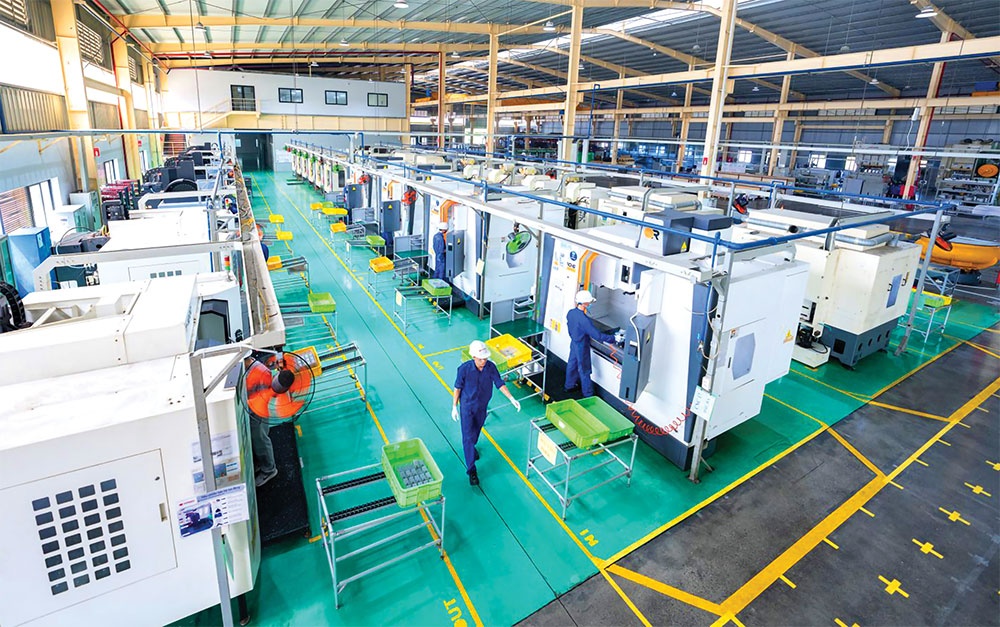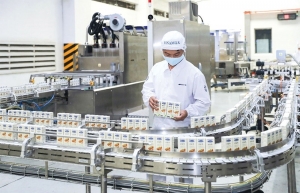Robust strategy can aid circular economy
 |
| Industrial areas are shifting rapidly to circular economic models, photo Le Toan |
Mai Thanh Duy, deputy general director of the Ministry of Natural Resources and Environment’s Institute of Strategy and Policy on Natural Resources and Environment, said last week that the ministry is completing a draft for a national action plan on implementing a circular economy (CE) model in Vietnam, which will be submitted to the government at the year’s end for consideration.
The model would be primarily aimed at combating pollution and achieving more sustainable development by reusing and recycling defunct products. It would likely have a major impact on all production and business activities in Vietnam as it will cover many obligatory activities for localities, industrial and economic zones, and enterprises to shift their traditional development models to low-carbon development models.
For example, under the draft plan, such zones and clusters must be shifted to a CE model. Localities that have been performing a green and eco-economic model shall have to complement new criteria to transform into a CE model.
Additionally, sectors and services such as waste treatment, restaurants, hotels, and dismantlement of building materials will be obligated to carry out the model.
“The plan will also offer assorted incentives on land, taxes and fees, tech application, and human resources development for enterprises with CE models,” Duy said. “This will create great momentum for businesses to perform the EC.”
After the plan is made public, localities and authorities of economic and industrial zones will have to accordingly formulate their own CE action plans, with concrete criteria for solutions.
Deputy Prime Minister Tran Hong Ha stated that there will be feasible and effective policies and incentives for Vietnam to develop its green economy, low-carbon economy, and a CE.
“If necessary, there must be a law on CE and a law on renewable energy, in addition to the existing one on environmental protection,” he stressed. “The current relevant legal documents are there, but are yet to be implemented fruitfully.”
“The government will in the coming time enact new incentives for enterprises to renew technology, apply high technology, and AI, and use new environmental-friendly materials,” he continued. “Also, some laws will have to be revised, such as those on investment, enterprises, and land.”
In Vietnam, CE development is mentioned in several legal documents including Article 142 of the Law on Environmental Protection, which states, “Every business must establish a management system and implement measures to reduce exploitation of natural resources, decrease waste, and increase recycling and reuse of waste from establishing a project and designing products or goods from production to distribution.”
However, the existing legal framework on CE remains vague, making it difficult for enterprises to perform related models.
“Businesses like us want that the government to soon promulgate specific regulations on CE models so that they can shift their production models,” said Nguyen Trung Anh, director of R&D and Sustainable Development at The PAN Group. “For example, the government can offer tax and fee incentives for companies that apply high technology to reduce greenhouse gas emissions.”
Tran Thanh Huong, ESG principal at Nokia Vietnam, proposed that there should be a government-led alliance for carrying out a CE and a low-carbon economy. This alliance will comprise representatives of economic sectors, enterprises, the government, institutes, and universities. “Currently Vietnam lacks of an effective ecosystem for sustainable development for enterprises,” Huong said.
However, many major companies have developed their own CE models by themselves. To save production costs, TH Group has been operating a system of solar power panels on the roofs of its Nghe An province farm cluster since September 2019, and the system has been connected with the national power grid.
Power produced from the panels has met one-fifth of the farm’s electricity demand. All nine farms in the cluster have been installed with the panels and, each year, the system can produce about 4,280MW, helping TH Group reduce about 2,100 tonnes of CO2 a year.
As well as acting as an electricity producer, the system also helps cool down the roofs and creates a good habitat for dairy cows.
For several years, TH Group has also been producing power from sugarcane bagasse. Mud waste and gas from the production process are also employed to generate electricity.
Elsewhere, SCG Packaging under Thai-backed SCG has applied its own CE model via a number of environmental friendly products, with one of which being paper beds.
The beds, easily installed and transported, are fully made of recycled paper, and were provided for many hospitals in Vietnam during the height of the pandemic.
SGC has also applied high technology to its cement production. The products are energy-saving, with technology helping reduce carbon emissions by about 115,000 tonnes a year. Moreover, the technology has also helped SCG reduce 59,000 tonnes of natural resources annually.
 | Key enterprises plug circular economy shift Company leaders have highlighted the need for a balanced approach of incentives and penalties as Vietnam’s business community explores a circular economy model. |
 | Unilever and Central Retail team up on plastic waste A ceremony on August 23 to launch a cooperative agreement between Unilever Vietnam and Central Retail Vietnam on plastic waste segregation is indicative of their joint commitment to alleviate the current burden on the environment and bring the ideals of the circular economy to fruition. |
What the stars mean:
★ Poor ★ ★ Promising ★★★ Good ★★★★ Very good ★★★★★ Exceptional
 Tag:
Tag:
Related Contents
Latest News
More News
- Global partnerships key to Vietnam’s IFC development (December 26, 2025 | 16:18)
- Vingroup pulls out of bid to invest in North-South high-speed railway (December 26, 2025 | 11:42)
- Strengthening supply chains through trade promotions and customs reform (December 24, 2025 | 14:00)
- PM orders investment model for North–South high-speed rail (December 22, 2025 | 17:43)
- LS Eco Energy to invest in Vietnam rare earth sector (December 22, 2025 | 17:31)
- Government moves to establish International Financial Centre (December 21, 2025 | 21:00)
- Vietnam's IFC to target global investment flows (December 21, 2025 | 18:00)
- Two national hospitals expand capacity with new facilities (December 20, 2025 | 09:00)
- Ha Tinh breaks ground on major Vingroup industrial and energy projects (December 19, 2025 | 18:24)
- EVN launches major power infrastructure projects nationwide (December 19, 2025 | 18:17)























 Mobile Version
Mobile Version